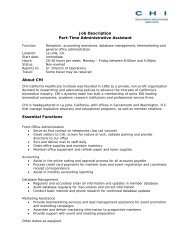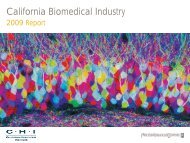California Biomedical Industry - California Healthcare Institute
California Biomedical Industry - California Healthcare Institute
California Biomedical Industry - California Healthcare Institute
You also want an ePaper? Increase the reach of your titles
YUMPU automatically turns print PDFs into web optimized ePapers that Google loves.
Workforce developmentA thriving entrepreneurial communityand highly skilled workforce are key tothe success of the biomedical industryin <strong>California</strong>. The synergies between<strong>California</strong>’s public and private collegesand the companies launched by theirfaculties and graduates led to the thriving“clusters” of schools, firms, investors andsuppliers in the Bay Area, Sacramento,Los Angeles, Orange County, Riversideand the San Fernando Valley, andSan Diego.As universities and companies havegrown, and the clusters have matured,the boundaries separating academicaand business have become morefluid. The same academic systemsthat inspired young researchers tolaunch their own companies, begantraining workers to perform technical,specialized and highly regulatedfunctions for those companies’development programs. In turn,companies supported the universities’foundations and helped shape theircurricula. <strong>Industry</strong> hired labs withinthe university system to do contractresearch and licensed additionaltechnologies or discoveries to improvetheir productsand writing competencies. Of the fourcategories queried, only computerskills were given promising scores.Respondents said that 50 percent hadsomewhat or completely adequateskills and none replied that they werecompletely inadequate.At the basic education level, thereremains the need to interest <strong>California</strong>’syouth in math and science at earlierages. In fact, 73 percent of the 2011 CEOSurvey respondents said that improvingK-12 education was the critical key toworkforce development in <strong>California</strong>(Figure 44).From an operational perspective,biomedical employers are lookingfor prospective employees who areprepared and committed to contributingto the organization’s activities and goals(Figure 55). There, too, respondentsfound the emerging workforce illpreparedin the functions that requireinquisitive thinking, with 35 percentsaying prospective employees wereleast prepared to conduct research.Manufacturing skills came in second at27 percent.The challenge and the opportunity ofensuring a strong biomedical workforceare both huge. <strong>California</strong>’s learninginstitutions and life sciences industrycontinue to respond in ways designedto enable the state’s ongoing dominancein biomedical innovation. The followingdescriptions illustrate the collaborativeways that industry and academia arereinforcing the state’s dominance in thelife sciences industry.Figure 43: 2011 CEO Survey: Rate the adequacy of <strong>California</strong>’s emergingworkforceCompletely inadequateSomewhat inadequateNeutralSomewhat adequateCompletely adequateMath Science Computer skills Reading & writing2%31%38%22%8%2%29%35%26%8%0%12%38%35%15%2%27%52%14%5%The science also became morecomplex with each new breakthrough.Researchers from different disciplinesbegan working together. Each appliedtheir expertise toward solving seeminglyintractable problems and madeheadway in brand new fields such asgenomics, gene therapy, personalizedmedicine, nanotechnology, stem cellresearch and more.Figure 44: 2011 CEO Survey: Whichof the following key area neededimprovement in educating theworkforce in <strong>California</strong>?19%Post universitytrainingFigure 45: 2011 CEO Survey: Of thefollowing choices, select the primarycapacity in which the workforce in<strong>California</strong> is least prepared.14%5%Education and training collaborationsare paying off, with companies citingthe local workforce as a key benefit andcritical consideration for locating andsustaining operations in <strong>California</strong>.Yet much work remains to be done.In fact, respondents to the 2011 CEOSurvey found the skills of the emergingworkforce — new high school andcollege graduates — lacking (Figure43). Their shortcomings are not only inmath and science skills, where the baris set especially high, but also in reading17%Post highschool training73%Kindergarten -12th gradeSource: Bureau of Labor Statistics Quarterly Census ofEmployment and Wages and Company Specific SEC filings.35%ComplianceManufacturingQuality assurance15%27%RegulatoryResearchVocational trainingSource: Bureau of Labor Statistics Quarterly CensusSource: Bureau of Labor Statistics Quarterly Census of Employment and Wages and Company Specific SEC filings.ofEmployment and Wages and Company SpecificSEC filings.3%<strong>California</strong> <strong>Biomedical</strong> <strong>Industry</strong> 2011 Report | 53






